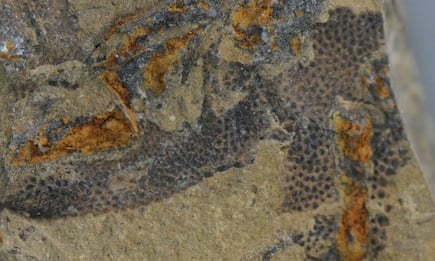Feathers even play into the hot blood/cold blood debate surrounding the dinosaurs. Theropods, despite being reptiles, are related to warm blooded birds and led active, predatory lifestyles. This suggests they may also have been warm blooded. Feathers would have aided the maintenance of a constant core body temperature, helping to retain heat generated by metabolic processes. This begs the question as to whether other dinosaur groups, for example the sauropods, may have been warm blooded and possessed feathers also. Indeed sticking feathers to each and every dinosaur species has been a recent trend in palaeontology.
 |
| The round impressions of the scales of Kulindadromeus |
 |
| The filamentous impressions of the feathers of Kulindadromeus |
Recently, a study has shown that feathered dinosaurs were a minority compared to those possessing scales. An international team of researchers analysed 75 dinosaur specimens which preserved soft tissue, including feathers or scales. They used the data to create a dinosaur family tree in which statistical models were applied to work out the odds of species having feathers at different points in dinosaur history.
'What we found from this analysis is that the first dinosaur was probably not feathered,' said Nicolás Campione from Uppsala University. 'Feathers clearly evolved in the dinosaur lineage, but right now, the data does not point to a feathered ancestor for them all. Untangling when these features first evolved will help us understand the origins of feathers and why they first arose, but the story may yet change. We are limited by the data we have.'
Feathers have a wide variety of roles, including facilitating flight, temperature regulation and mating displays. Dinosaur reconstruction, with or without feathers, has a huge impact on the structure of its palaeobiology.